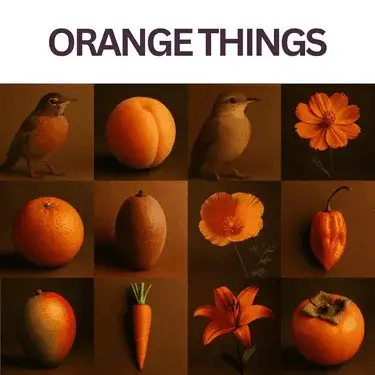The list of orange things includes items from many different categories, from stunning orange flowers to exotic orange animals. Dive into this orange world filled with the energy and warmth of colors and discover these wonderful orange colored beings found in nature.
Flowers
California poppy

California poppies are a type of plant that blooms in orange and belongs to the Papaveraceae family. It attracts attention with its colorful flowers in summer and is sometimes used in food.
Orange Lily

Orange lily is a plant of European origin notable for its striking orange flowers and reddish-brown spots. It can grow both in mountain meadows and on slopes.
This beautiful plant, which reproduces by forming air bulbs (bulbil) in the upper leaf axils, is unfortunately quite poisonous and dangerous for cats.
Sulfur cosmos

Cosmos sulphureus is an eye-catching flower that blooms in bright shades of yellow, orange and red. Attracting butterflies and birds, this beautiful plant is often seen in mass plantings along roadsides and is a popular choice in home gardens.
This species is easy to grow and prefers sunny environments. In addition, wool is dyed with orange-yellow natural dyes obtained from Cosmos sulphureus flowers.
Corn Lily
Corn Lily is an ornamental plant often preferred in temperate climates due to its showy flowers and easy cultivation.
The interesting thing is that it is completely edible, including the flowers, leaves and roots.
Flame Azalea
Flame Azalea is a shrub native to North America, noted for its bright orange flowers. It usually blooms in May and June. Although poisonous, it is popular in garden arrangements because of its showy flowers.
This beautiful plant grows naturally in the Appalachian Mountains and has many cultivars and domesticated varieties.
Canna
Canna is a plant species that grows in tropical and subtropical regions, attracting attention with its large leaves and vibrantly colored flowers. Although not true lilies, they are closely related to the ginger and banana family.
Orange Hawkbit
Eye-catching with its orange-colored flowers, Orange Hawkbit is a perennial herb that grows in the alpine regions of Europe.
Used as an ornamental plant in gardens, it is a popular pollen source for a variety of insects such as butterflies and bees.
Gerbera jamesonii
Gerbera jamesonii is an ornamental plant of African origin, striking with its striking flowers. This beautiful plant, pollinated by bees and other insects, is the ancestor of the world-famous gerbera flowers and forms the basis of various hybrid species.
Tulip
Tulipans are bulbous and perennial plants that emerge with their dazzling colors in spring. These beauties, which have about 75 species, bloom in many colors from white and yellow to pink and red.
Some even have spots of different colors at the base of their tepals (leaf-like structures).
Crocosmia
Crocosmia is an attractive plant with colorful flowers from eastern and southern Africa. These beautiful flowers, belonging to the Iridaceae family, have vibrant colors in red and orange tones.
Crocosmia, also known as Montbretia, creates a warm atmosphere in gardens with its sword-shaped leaves and brightly colored flowers. Derived from the Greek words "krokos" (saffron) and "osme" (fragrance), its name comes from the way the dried leaves emit a strong saffron-like scent when dipped in hot water.
Orange Coneflower
Orange Coneflower is a perennial with bright yellow daisy-like flowers native to eastern North America. These attractive flowers color gardens in summer and their seeds ripen in winter, making them a favorite food of finches.
Propagated by both stoloniferous stems and seeds, Rudbeckia fulgida adds vitality and color to natural habitats and gardens.
Cape honeysuckle
Cape honeysuckle, although not really a hyacinth, is a plant that draws attention with its tubular flowers native to southern Africa and its ivy structure that can reach 2-3 meters in height, as the name suggests.
The color of its flowers ranges from orange, orange-red and apricot tones.
A source of nectar for South African birds and insects, this plant is often used in gardens and creates a space full of bright colors, especially in sunny areas.
Busy Lizzie
Busy Lizzie (Impatiens walleriana) is a plant originating from eastern Africa that adorns the gardens with its vibrant colors and abundant flowers. It attracts attention with its soft and delicate structure.
It is available in many colors from white to purple and is a popular ornamental plant around the world.
Trumpet Vine
Trumpet Vine is an American ivy plant famous for its striking reddish-orange trumpet-shaped flowers.
This plant, which can grow up to 10 meters tall, is a popular attraction, especially for nectar-feeding birds and insects. Trumpet Vine, which is often grown in gardens, dazzles with its natural beauty.
Lion's Tail
Lion's Tail is a South African native ornamental plant of the mint family, noted for its orange flowers, known for its medicinal properties.
This plant, which is preferred in gardens for both beauty and health, is a nectar source for birds and butterflies in its natural habitat.
Torch Lily
Kniphofia uvaria, also known as torch lily or angry poker, is an ornamental plant originating from South Africa, notable for its colorful flowers and interesting form.
It is often used in gardens and is popular around the world.
You Might Also Like: Yellow Things, Pink Things, Red Things
Fruits
Mango

Mango is a colorful and sweet fruit that grows in tropical regions. It originally comes from regions between Myanmar, Bangladesh, and India, and there are hundreds of varieties around the world.
Mango ripening, especially in summer, offers a fascinating taste and aroma. The national fruit of India, Pakistan and the Philippines, this delicious fruit is also the national tree of Bangladesh.
Persimmon

Persimmon, is the edible fruit of trees belonging to the genus Diospyros.
This fruit, which is usually orange-red in color, becomes sweeter and softer as it matures. Available in various shapes and sizes, persimmon can also be used in beverages such as tea and coffee.
Apricot

Apricot is an aromatic fruit that is indispensable for summer months with its sweet and juicy fruit. It is usually obtained from trees belonging to the genus Prunus and can vary in color from yellow to orange.
This delicious fruit is the star of many recipes, from desserts to salads, and is even dried and consumed in winter. In addition, apricot kernels are also very beneficial for health.
Tangerine

Tangerine is a citrus fruit with an orange color, sweet and strong flavor. The name was first used for the fruit from Tangier, Morocco. This fruit, which is not smaller and rounder than an orange, is consumed especially in autumn and spring.
A versatile fruit, tangerin is featured in many recipes, from salads to desserts and main courses.
The bark is used in spices, zest or drinks. In 2021, 60% of the world's tanger production was carried out by China. Also, tangerin contains significant amounts of vitamin C and is low in other nutrients.
Orange ( For Sure)
Orange is one of the most popular citrus fruits around the world with its sweet and juicy fruit. Orange is the most cultivated fruit tree and is found in abundance in tropical and subtropical climates.
This delicious fruit is both eaten fresh and used in the production of juice and perfume.
Pumpkin
Pumpkin, which belongs to the Cucurbitaceae family, has an important place in both cuisine and cultural activities.
Originating from North America, this vegetable draws attention with its colorful skins and delicious interior.
Especially in North America, it is carved for Halloween and decorated the Thanksgiving table as pumpkin pie.
Kumquat
Kumquat is famous for its tiny fruits that look like oranges but are the size of olives.
This tropical fruit, which belongs to the citrus family, is resistant to cold and heat and attracts attention with its shiny leaves.
Originally from Southern China, kumquat is known for its delicious and sweet crust and slightly sour interior. Despite its small size, it is quite rich in vitamin C.
This exotic fruit is popular for growing in gardens and for serving on fruit plates.
Papaya
Papaya is one of the members of the tropical fruit family and is famous for its delicious fruit. First cultivated in Mexico and Central America, this exotic fruit is also called papaw or pawpaw.
Its fruit, which is about 15-45 cm long and 10-30 cm in diameter, becomes soft and orange when ripe.
The papaya tree is a small tree with a single trunk and leaves that can reach 5-10 meters in height. This sweet fruit is often preferred in kitchens, especially in salads and desserts.
Cantaloupe
Cantaloupe is one of the varieties of melon, which is a sweet and delicious fruit and is known by different names in Australia, New Zealand and South Africa.
Cantaloupe, which weighs between 0.5 and 5 kilograms, refers to C. melo type melons with orange flesh.
Butternut squash
Butternut squash is a type of winter squash with a sweet and nutty flavor and is known as butternut pumpkin in Australia and New Zealand.
This fruit, which is rich in fiber, vitamin C, magnesium and potassium, can be used in various dishes. It is especially preferred in soups, roasted and baked dishes by being fried or pureed.
Orange Foods
Carrot

Carrot refers to a delicious root vegetable that is usually orange in color but also comes in purple, black, red, white, and yellow color options.
Originally of Persian origin, this vegetable was originally grown for its leaves and seeds.
Interestingly, carrots have historically been white in color, and colored carrots have emerged over time. Now, if you wish, you can consume carrots raw or cooked and enjoy this healthy vegetable!
Habanero

Habanero is a colorful and very hot pepper that is often used in Mexican and Yucatan dishes. With its bitterness ranging from 100,000 to 350,000 on the Scoville scale, it leaves an unforgettable impression on the palate for a long time.
This pepper, which takes its name from Havana, the capital of Cuba, originally originated in the Amazon and spread to the world over time. Habanero, which has different variations, is also indispensable for hot pepper producers trying to break world records.
This pepper, which is used in both dishes and sauces, is known as a favorite of adventurers and hot lovers.
Pouteria sapota

Pouteria sapota, or mamey sapote, is a delicious fruit native to Mexico and Central America.
This fruit, which is rich in vitamins B6 and C, is used in pureed milkshakes, smoothies and ice creams.
The unique flavor profile of Mamey sapote includes flavors such as sweet potato, pumpkin, honey, plum, peach, melon and cherry.
Hippophae
Hippophae are deciduous shrubs from the family Elaeagnaceae, known as sea buckthorn. These plants are famous for their orange-yellow fruit and have been used for centuries in food, traditional medicine, and skin care.
Sea buckthorn are plants that are resistant to freezing temperatures and help prevent soil erosion thanks to their rapidly spreading root systems. These plants are even effective in soil enrichment and providing wildlife habitat.
Sweet potato
Sweet potato is a popular root vegetable for its colorful roots and sweet taste.
Belonging to the morning glory family, this herb is used in delicious dishes around the world. Different colored sweet potatoes can also vary in taste and moisture content.
Its leaves and shoots are sometimes consumed as foliage. This delicious and colorful vegetable is a great choice to add joy and health to your kitchen.
Turmeric
Turmeric, which is from the ginger family, is known as a bright yellow spice. Known for its powerful antioxidant properties, this root herb is used in Asian cuisine to add color and flavor, especially in curries. Turmeric, which is an excellent option for both health and taste, adds a completely different taste to your tables.
Peach
The peach is a delicious and juicy fruit originating from China and is loved and consumed around the world. Peaches, the same species as smooth-skinned nectarine, are known for their hairy rind and sweet flavor.
Interestingly, peach seeds have an almond-like flavor and are used to make affordable marzipan. Peach trees are relatively short-lived and are replanted after 8-10 years in some areas.
Throughout history, peach trees and fruits have traveled around the world and are found in the cuisines of many cultures today.
Orange Animals
Rufous hornero

The rufous hornero is a medium-sized, cute bird with reddish-brown plumage that lives in the eastern parts of South America.
Also known as the Red Oven, this songbird is specifically Argentina's national bird. The rufous hornero is famous for making mud burrows, which resemble old wood-fired ovens.
American robin

American robin is one of the most common birds in North America, notable for its reddish-orange breast. Although similar in name to the European nightingale, these two species are not closely related.
This cheerful bird, which starts to sing especially at sunrise, prefers fruit and seeds as well as maggots and insects while feeding..
Orange-crowned warbler
The Orange-crowned warbler is a small and charming songbird notable for its olive-green plumage and yellow underparts. It gets its name from its often invisible orange top.
These viviparous birds move from the ground to low branches in woodland areas in search of insects, fruit and nectar.
With their singing and cheerful songs, they make you feel the energy of nature.
Orange Ladybird
The orange ladybug is a cute beetle species commonly found in woodlands, with a bright orange color and 16 white spots on it.
Both adults and larvae play an important role in the balance in nature by eating molds and small aphids that infect plant leaves.
Orange tip
The orange-tipped butterfly is a beautiful butterfly belonging to the Pieridae family, known for the prominent orange wingtips of the males.
They are frequently seen on forest edges and meadows in spring. Females lack the orange color and have green and white spotted wings that provide excellent camouflage when perched on flowers.
Julia Butterfly
Julia Butterfly is a stylish butterfly with bright orange wings that lives in tropical and subtropical regions.
Feeding on both flower nectar and turtle tears, this fast flyer is popular in butterfly houses. Males are more vibrant in color and butterflies have a complex mating behavior.
Cancer productus
Cancer productus is a species known as the Red Reef Crab and lives on the west coast of North America.
Notable for its wide claws and black tips, this crab is known for both its carnivorous and sweet meat. It is one of the favorite prey of the giant Pacific octopus (Enteroctopus dofleini).
Flame-colored tanager
The flaming urchin is a medium-sized American songbird notable for its bright red-orange males and more yellowish-orange females.
It lives in areas from Mexico to Panama and is rarely seen in the United States.
Zelus longipes
Zelus longipes is a species of assassin bug that lives in the Americas. It is used as a biological control agent by preying on agricultural pest caterpillars and specifically targets pests in corn fields.
Automeris io
Automeris io, also known as the io moth or peacock moth, is a species of moth found in North America. This moth species is distinguished by females with brownish purple wings and males with bright yellow wings.
However, the caterpillars of this month, unlike an ordinary moth caterpillar, are filled with a very painful venom and can be released even with light touch.
Therefore, the defense mechanism of their caterpillars is quite effective and helps protect them from their predators.
Baltimore oriole
The Baltimore oriole is a widely migrating bird in eastern North America.
This name is given because the colors of the men are similar to the colors of the 17th century Lord Baltimore's coat of arms. He is the name and mascot of the Baltimore Orioles baseball team.
It is one of the bird species described by Carl Linnaeus. Their name is given to a family in the ancient world, but physically similar.
With a length of 17-22 cm and a wingspan of 23-32 cm, the males of this bird are orange and black, and the females are yellowish-brown.
Grapsus grapsus
Grapsus grapsus is one of the most common crab species on the west coast of America. Also known as rock crab. These crabs live on the black lava shores of volcanic islands, while their young are black or dark brown, while adults can be brown, pink, or yellow.
They have also been observed removing ticks from marine iguanas in the Galapagos Islands. Crabs collected by Charles Darwin on the HMS Beagle were also explored by Ed Ricketts and John Steinbeck.
Orange Raccoon
Raccoon is a mammal native to North America. It is the largest member of the Procyonidae family and has a ring-shaped tail on its back.
It is known to be a versatile animal and its diet is omnivorous. Raccoons usually live in trees and use their hands to grab their food. They are known as pests, especially in the eyes of people living in cities, but they have an important place in the mythology of the local people.
Corn snake
The corn snake is a species of snake belonging to the Colubridae family in North America. It is non-toxic and harmless. It is beneficial to humans by keeping the population of rodents damaging in agricultural areas under control.
It derives its name from the resemblance of the patterns on the abdomen to the grains of maize, not the fact that it is especially found in corn bins.
Living for about 10-15 years in nature, this snake can live up to 23 years in captivity. Even fruitful hybrids called "jungle corn snake" can be produced by crossing them with the Californian Kingsnake.
Red Squirrel
The red squirrel is a species of tree squirrel common in Europe and Asia. Its fur becomes thicker and darker in winter.
Their food is mostly the seeds of trees, mushrooms, fruits and nuts. It lives with people in residential areas and is usually solitary.
Although their numbers have decreased due to the presence of gray squirrels, their population is increasing in Scotland due to conservation efforts and increased hunters.
Ethiopian wolf
A lithe, agile and graceful African wolf, the Ethiopian wolf is an endemic species living in the heights of Ethiopia. With its red and white plumage and long narrow head, it resembles a kojote but is smaller.
Due to the special diet of Afroalpine rodents, it is not a common feeder and is one of the rarest wolf species on earth.
The total adult population is 360-440 individuals, with most of the population located in the Bale Mountains. Habitat degradation such as increased pressure and overgrazing by the expansion of the human population are among the biggest threats to the Ethiopian wolf.
Gulf fritillary
The Gulf fritillary butterfly is a species of the Nymphalidae family and lives in southern America and the USA.
The leaves of the species of Passiflora plants are the food source for the fry of these butterflies. They repel predators by releasing scented chemicals.
The pheromones secreted by female butterflies to attract males are important in mate selection.
This butterfly species, which is commonly seen in butterfly gardens, attracts attention with its bright colors.
Red crossbill
The red-winged goldfinch, also known as the "gatebird", is a small bird that uses its crossed beaks to extract seeds from cones such as acorns and pinecones. Males are usually red or orange, while females are green or yellow.
Different types of goldfinches are classified according to the size and shape of their beaks. Red-winged beards are closely related to the conifer production of their hunting grounds, as they depend on their main food source consisting of cone seeds. Spawning times and movements also depend on the availability of cones.
Koi
Koi fish are different color variations of the Amur carp species, which is native to northern Asia. As a result of the selective breeding processes that started in Niigata, Japan at the beginning of the 19th century, many varieties have emerged in different colors, patterns and sizes.
Koi fish are often kept in garden ponds and water gardens for ornamental purposes.
Vermilion Flycatcher
The Vermilion flycatcher, or Red-Tailed Flycatcher, is a small bird native to South America and southern North America. It attracts attention with its vivid red color, unlike the Tyrannidae family, which is usually pale in color.
Males with bright red crown, breast and underside feathers, while females do not bear this vivid coloration. They fly in the air and feed on insects they hunt.
Flame angelfish
Flame angelfish is a marine hybrid species that lives in warm tropical waters. Its body is bright orange-red with black stripes and spots on the flanks.
This beautiful fish is popular with aquarium hobbyists and can often be kept with corals. Provided adequate nutrition, they do not tend to eat soft tissue creatures such as corals or mussels.
Starfish
Flame angelfish is a popular aquarium fish known for its vibrant coloration and distinctive markings. Found in the Indo-Pacific region, these small fish are typically less than 4 inches in length and have a bright red-orange body with vertical black stripes and blue accents.
Royal angelfish
Royal Angelfish is an elegant and colorful marine fish that lives on coral reefs. This fish species is found in the tropical regions of the Indian Ocean, Red Sea and Pacific Ocean.
Its body is narrow and long, its color is orange and blue tones, and it has blue dots on its back. Their fins are also covered with orange and blue stripes.
Monarch butterfly
The monarch butterfly is one of America's best-known butterflies and is known for its annual migration. The eastern population living in North America migrates towards Mexico on a journey of thousands of kilometers in the fall.
The western population migrates to California. The wings of monarch butterflies are striped in black, orange and white. They can easily be confused with the viceroy butterfly, which is the same color and pattern.
Scarlet tanager
The Scarlet tanager is one of America's medium-sized songbirds. The males are intensely red, while the females are yellowish on the underside and olive green on the top. They live in deciduous forests and suburbs in the summer.
Like other members of the piranga genus, they are classified as belonging to the eagle bird family, although they do not have a thick conical beak. Their eating habits include insects, fruit, slugs and spiders. Since they need at least 10-12 hectares of forest, they breed in large flat forest areas.
Clownfish
Although it is a tiny fish like a piggy bank, the clownfish is one of the most cheerful and lively species of the seas. Clownfish, which impress with its colorful and eye-catching appearance, have a mutualistic relationship with jellyfish.
Jellyfish protect clownfish from predators, while clownfish protect jellyfish from parasites that eat them. Some species can only live with certain jellyfish, while others can live with different jellyfish.
Red salamander
The red salamander living in eastern North America attracts attention with its bright red color and black spots. It is one of the gillless salamander family and breathes through its skin.
Their larvae feed on other animals and consume more food as they grow in size. Adult salamanders feed on insects, spiders and other small animals.
Red fox
The red fox is the largest of the true foxes and is found throughout almost the entire Northern Hemisphere, North America, Europe, most of Asia and parts of North Africa. Despite its name, it can also produce individuals in other colors.
There are 45 subspecies. Red foxes are often found in pairs or families and can attack small rodents as well as rabbits, squirrels, game birds, reptiles, invertebrates and juvenile parasites.
Golden lion tamarin
Golden lion tamarin is recognized for its bright crimson orange fur and extra-long hair on its face and ears.
This species is found in the Atlantic coastal forests of Brazil and is among the endangered species. According to the last census of the wild population, only 3,200 individuals remained.
However, there is also a captive population of 490 individuals kept in approximately 150 zoos.
Ethiopian wolf
Ethiopian wolves are one of Africa's rarest and most endangered carnivores. They are known for their long and narrow skull and red-white plumage. Although they resemble coyotes in size and build, they have a highly specialized diet with Afroalpine rodents.
Gila monster
The Gila monster is a venomous species of lizard that lives in the southwestern United States and northwestern Mexico. A heavy, generally slow-moving reptile up to 56 cm (22 in) long, the Gila monster is the only venomous lizard in the United States.
His skin, which has two black and white stripes, is covered with small pearl-shaped bones called osteoderm, a bony tissue.
Tomato frog
The Tomato Frog gets its name from its bright red color. When threatened, it swells its body and secretes a thick substance that numbs the eyes and mouth of the predator.
The substance can sometimes cause an allergic reaction in humans. The life span is 6-8 years and they are active at night. They eat small insects and invertebrates.
Reproductive activities continue in every month of the year. There are 3 different species and all are endemic in Madagascar.
Mushrooms
Lea's mycena
Lea's mycena is a species belonging to the genus Mycena. It is characterized by an orange-colored cap and stems and gills with a reddish-orange border.
They usually grow in dense groups on deciduous woods. The pigment that provides the orange color of this mushroom species has antibiotic properties and has a cytotoxic effect against cancer cells.
Omphalotus olearius
Omphalotus olearius, popularly known as Jack-o'-lantern mushroom, is a poisonous mushroom species that attracts attention with its orange color and bioluminescent feature.
Consuming this mushroom, which can be mistaken for its chancre appearance, can cause severe cramping, vomiting and diarrhea. However, when viewed carefully, the gilts of this fungus emit a blue-green light in the dark.
This interesting property occurs as a result of the interaction of an enzyme, luciferase, on a compound called luciferin.
Aleuria aurantia
Aleuria aurantia is an orange-capped mushroom that resembles a fallen orange peel.
It is usually harvested in August and September and is considered edible, but collecting can be difficult.
In Europe it can sometimes be confused with poisonous mushrooms, so it's important to be careful. It is also quite interesting as it has spores in spray form with a little movement like wind or touch.
Orange Jelly Fungus
Dacrymyces chrysospermus, aka "Orange Jelly Fungus", is a fungus that grows in the dead wood of conifers and has an orange gelatinous appearance.
Under the microscope, it is distinguished by its 7-segmented basidiospores, which are larger than other Dacrymyces species. It is widely found in North America and Europe and gets its name from its orange gelatinous appearance.
Stones
Carnelian
Carnelian is a brown-red semi-precious stone used in many works of art. It is formed by the coloring of chalcedony, a hard mineral, with the effect of iron oxides.
This stone, which has been used in jewelry, seals and ornaments since ancient times, was known as an important seal stone in the Roman period.
It is also frequently mentioned in the Bible. Nowadays it can be found in places like Peru, Sri Lanka, Thailand.

Orange Related Other Articles: